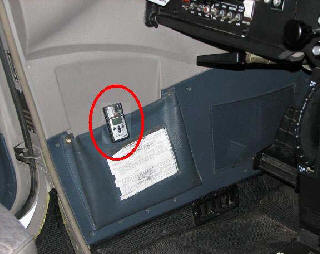 |
|
|
|
|
|
|||
|
By |
||||
 |
March 17, 2010 - The FAA has issued a Special Airworthiness Information Bulletin (SAIB) advising the owners and operators of general aviation (GA) aircraft of an airworthiness concern, specifically the need to inspect properly and maintain the exhaust system to prevent carbon monoxide leakage into the cabin and to install a commercially available carbon monoxide detector in the cabin.
This revision adds
the Federal Aviation Administration (FAA) This SAIB is in response to a National Transportation Safety Board (NTSB) investigation of an accident on December 17, 2000, where a Beech Model BE-23 aircraft impacted terrain killing the commercial-rated pilot, the sole occupant of the airplane. The NTSB determined the probable cause of the accident was in part “the pilot’s incapacitation due to carbon monoxide (CO) and a fractured muffler.” |
|||
| Carbon Monoxide Detectors Attached to the Left-Door Pocket (a) and Right-Door Pocket (b) With Suspender Clips | ||||
|
The FAA tasked The report shows that 43 commercially available CO detectors, sampled from each of the five sensor technology types (biometric, electrochemical, spot, infrared, and semiconductor) were surveyed to determine the most appropriate sensor technology. The electrochemical sensor-based CO detectors were found to be most suitable for use in the GA environment. Limited field testing using portable electrochemical CO detectors was conducted in two GA aircraft models to determine the best location for a CO detector. Based on the analyses of collected CO data, the instrument panel appeared to be the best location for the placement of CO detectors. The report notes that, to increase the probability of being able to detect at least 50 parts per million (PPM) anywhere in the cabin, the CO detector should be set at a lower alarm threshold of 35 PPM. Performance parameters and specifications of various CO detectors (available on the market) were compiled into a database as shown in Tables B-2 through B-5 of the technical report. |
||||
|
Recommendation
The FAA recommends
that you do the following:
1. Consider the
information in the technical report, and use a CO detector while
operating your aircraft.
2. To detect
leakage of gases into the cabin due to cracks in the exhaust system,
conduct engine run up tests with cabin heat on and check for CO in the
cabin with a hand-held CO detector during 100 hour and annual
inspections. 3. Continue to inspect the complete engine exhaust system during 100 hour/annual inspections and at inspection intervals recommended by the aircraft and engine manufacturers in accordance with their applicable maintenance manual instructions. |
| ©AvStop
Online Magazine
Contact
Us
Return To News
|
|
